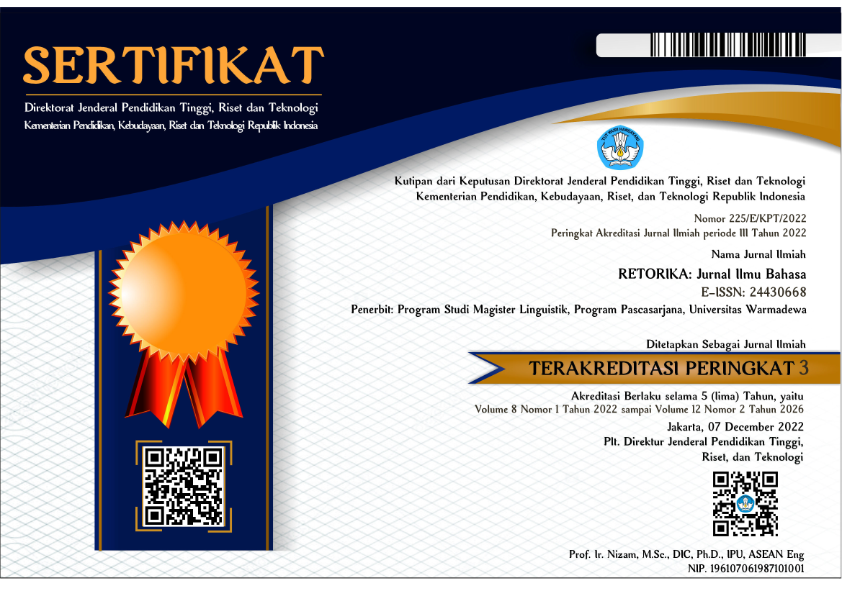A research of semantic field Semantic Field of Oral Activity in Sasak Language in The Ampenan District
Abstract
This research is entitled Semantic Field of Oral Activity in Sasak Language at Ampenan District. The aim of this research is to classify and analyze the components of the oral activities in Ampenan District. This is qualitative research that uses a descriptive approach. To collect data, this research uses the introspection method; listening method with tapping techniques, uninvolved listening techniques, note-taking techniques; and cakap (speak) method. Furthermore, to analyze the data, this research used the intralingual matching method to classify lexemes of the semantic field and the extra-lingual matching method to analyze the components of each lexeme. Meanwhile, to present the results of the analysis, both formal and informal methods are used. The data of this research include lexemes of the semantic field of oral activity and the components of each lexeme in the Sasak language. A total of 30 oral activity lexemes were found to occupy the semantic field with the classification: (1) the oral activity, to eat, (2) to drink, (3) to speak, (4) to make sounds, and (5) to produce something (besides sound) from the mouth.
References
Austin, Peter K. 2010. “Reading the Lontars: Endangered Literature Practices of Lombok, Eastern Indonesia.” Language Documentation & Description 8(Special issue on oral literature and language endangerment): 27–48.
Chaer, Abdul. 2009. Pengantar Semantik Bahasa Indonesia. Jakarta: Rineka Cipta departemen Pendidikan Nasional.
Kridalaksana, Harimukti. 2011. Kamus Linguistik. Jakarta: Gramedia.
Mahsun. 2006. Kajian Dialektologi Diakronis Bahasa Sasak Di Pulau Lombok. Yogyakarta: Gama Media.
Mahsun. 2019. Metode Penelitian Bahasa: Tahapan Dan Strategi, Metode Dan Tekniknya Edisi Revisi. Jakarta: Rajawali Pers.
Nida, Eugene Albert. 1975. Exploring Semantic Structures. Mu?nchen: Fink.
Pateda, M. 1986. Semantik Leksikal. Nusa Indah.
Setiawan, Aan. 2011. “Bahasa Daerah Dalam Perspektif Kebudayaan Dan Sosiolingustik?:” Proceedings: International Seminar Language Maintenance and ShiftUniversitas Diponergoro 66(July): 37–39.
Suhaemi, Evi. 2018. “Medan Makna Aktivittas Mulut Bahasa Sumbawa Dialek Taliwang.” https://eprints.unram.ac.id/6322/1/JURNAL SKRIPSI EVI.pdf.
Widiastuti, Enis. 2016. “Medan Makna Leksem Aktivitas Wajah Di Desa Kawo Kecamatan Pujut Kabupaten Lombok Tengah.”
Copyright (c) 2024 RETORIKA: Jurnal Ilmu Bahasa

This work is licensed under a Creative Commons Attribution-ShareAlike 4.0 International License.
This journal provides immediate open access to its content on the principle that making research freely available to the public supports a greater global exchange of knowledge.
All articles published Open Access will be immediately and permanently free for everyone to read and download. We are continuously working with our author communities to select the best choice of license options, currently being defined for this journal as follows: Creative Commons-Non Ceomercial-Attribution-ShareAlike (CC BY-NC-SA)
 Abstract viewed = 71 times
Abstract viewed = 71 times
 PDF downloaded = 35 times
PDF downloaded = 35 times

2.png)














